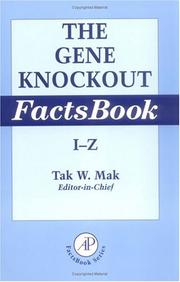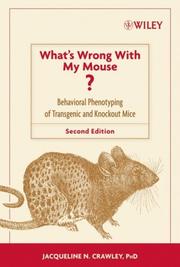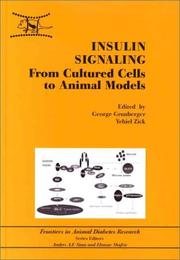| Listing 1 - 10 of 43 | << page >> |
Sort by
|
Dissertation
Year: 2004 Publisher: Liège : Université de Liège. Faculté de Médecine. Section des Sciences biomédicales,
Abstract | Keywords | Export | Availability | Bookmark
 Loading...
Loading...Choose an application
- Reference Manager
- EndNote
- RefWorks (Direct export to RefWorks)
MICE, KNOCKOUT --- PHYSIOLOGY --- MICE, KNOCKOUT --- PHYSIOLOGY
Article
Abstract | Keywords | Export | Availability | Bookmark
 Loading...
Loading...Choose an application
- Reference Manager
- EndNote
- RefWorks (Direct export to RefWorks)
Behaviour. --- Knockout. --- Prolactine.
Book
Year: 2006 Publisher: Bruxelles: UCL,
Abstract | Keywords | Export | Availability | Bookmark
 Loading...
Loading...Choose an application
- Reference Manager
- EndNote
- RefWorks (Direct export to RefWorks)
Aims/Hypotheses. Adiponectin is an adipokine that exhibits insulin-sensitising, fat-burning and anti-inflammatory properties as well as modulatory effects on oxidative stress. We investigated the protective biological functions of ApN in skeletal muscle on ApN-knockout (KO) mice, compared to wild type mice. We hypothesized that the muscle of ApN-KO mice would undergo more serious inflammatory reactions, oxidative damage or metabolic perturbations when submitted to inflammatory stress or diabetogenic diet.
Methods. ApN-KO mice were used and compared to wild-type (WT) littermates. These two types of mice were divided in three groups. The first group was fed with a standard diet. The second one was fed with a high sucrose (HS) diabetogenic diet 6 weeks. The third group was injected with lipopolysaccharides (LPS) to induce acute inflammatory stress. At the end of the experiments, blood was sampled and tibialis anterior muscles were collected for mRNA measurements and immunochemistry.
Results. Plasma levels of free fatty acids were increased in ApN-deficient mice fed with standard or HS diet. Moreover, the HS diet led to an increase in plasma thiobarbituric acid reactive substances (TBARS), marker of systemic oxidative stress and of muscular levels of TNF-α mRNA in ApN-KO mice. Immunohistochemistry experiments showed an upregulation of peroxiredoxin-5 and caspase-6 expression in the muscle of ApN-KO mice when compared to WT littermates. These proteins are oxidative stress and apoptose markers, respectively. These abnormalities were observed in the three experimental conditions, but were more pronounced after LPS injection. Finally, in contrast to WT mice, there was an ectopic accumulation of lipids in the tibialis anterior of ApN-KO mice that was worsened following LPS injection or HS diet.
Conclusions/Interpretation. ApN deficiency led to metabolic complications and muscular injury in the mice fed with standard or HS diet or injected with LPS. These findings, more pronounced after LPS injection, suggest that ApN is a local protection to counteract the ectopic lipids storage and oxidative stress but also inflammation L’ApN est une adipocytokine ayant un rôle fondamental dans l’homéostasie énergétique et possédant à la fois des propriétés anti-inflammatoires et antioxidantes. Nous avons étudié les fonctions biologiques de l’ApN dans le muscle squelettique des souris KO-ApN comparées à des souris sauvages. Nous avons posé l’hypothèse que les muscles des souris KO-ApN devraient présenter des perturbations métaboliques ainsi qu’une réaction inflammatoire exacerbées suite à un stress inflammatoire aigu ou à un régime diabétogène.
Les souris KO-ApN sont comparées à des souris sauvages. Ces deux types de souris ont été divisés en trois groupes. Le premier groupe a reçu un régime standard. Le second a été soumis à un régime riche en sucrose (RS) durant six semaines. Enfin, le troisième groupe a été injecté au LPS (lipopolysaccharides) pour induire un stress inflammatoire aigu. A la fin de l’expérience, des échantillons de sang ont été prélevés et les muscles tibialis anterior ont té disséqués afin d’effectuer une extraction d’ARNm et des marquages immunohistochimiques.
Nos résultats montrent une augmentation des acides gras plasmatiques chez les souris KO-ApN soumises à un régime standard ou riche en sucrose. De plus, les souris KO-ApN sous régime riche en sucrose avaient des concentrations de TBARS plasmatiques et des taux d’ARNm TNF-α dans leur muscle plus élevés que les souris sauvages. A ces perturbations, s’ajoutaient au niveau des muscles, une augmentation des protéines PRDX5 et caspase-6 ainsi qu’une atteinte musculaire accompagnée d’une accumulation ectopique de lipides dans les muscles des souris KO-ApN soumises aux trois conditions expérimentales. Notons que ces observations étaient exacerbées chez les souris KO-ApN injectées au LPS.
En conclusion, l’invalidation du gène de l’ApN entraîne des complications métaboliques et une atteinte musculaire chez les souris soumises à un régime standard ou riche en sucrose ou encore injectées au LPS. Ces données, plus prononcées chez les souris injectées au LPS, suggère que l’ApN est une protection locale contre le stress oxydatif et l’accumulation ectopique de lipides mais également contre l’inflammation
Book
Year: 2006 Publisher: Bruxelles: UCL,
Abstract | Keywords | Export | Availability | Bookmark
 Loading...
Loading...Choose an application
- Reference Manager
- EndNote
- RefWorks (Direct export to RefWorks)
Several physiological and pathological conditions cause muscle atrophy. Muscle mass los sis associated with decreased muscle strength and mobility, which contribute to increase morbidity and mortality risk.
A great number of catabolic conditions are associated with hypercortisolism and glucocorticoids, frequently used as immunosuppressive and anti-inflammatory drugs, induce muscle atrophy. It makes therefore important to understand the mechanism of the catabolic action of the glucocorticoids with the aim to identify new tools to protect muscle mass from atrophy. Since glucocorticoid-induced muscle atrophy is associated with an induction of muscle myostatine (Mst), a negative regulator of muscle mass, and overexpression of Mst leads to muscle atrophy, Mst can be suggest to be necessary for glucocorticoids to exert their atrophic effects on muscle. If this hypothesis comes true, Mst would represent a potential attractive therapeutic target for treatment of muscle atrophy induced by glucocorticoids.
The goal of our work to investigate whether inhibition of Mst activity, during pre- and postnatal life, could prevent muscle atrophy caused by glucocorticoids.
First, we wanted to know if Mstn gene disruption could prevent muscle atrophy caused by glucocorticoids. Using an Mst KO mouse model, we have demonstrated that Mstn gene disruption protects the animal treated by glucocorticoids from muscle atrophy, through downregulation of the ubiquitin-proteosome and lysosomial proteolytic pathways.
Secondly, we blocked Mst activity during postnatal life by surexpression of follistatin, one of his carrier protein which inhibits its action. Un fortunately, the surexpression of follistatin had caused muscle inflammation, distorting our results. The presence of this inflammation did not allow us to determine whether surexpression of follistatin protects skeletal muscle mass from atrophy induced by glucocorticoids. The aim of ongoing experiments is to inhibit Mst expression by siRNA De nombreuses situations cliniques favorisent le développement d’une atrophie musculaire. Cette diminution de la masse musculaire est responsable, non seulement d’une perte de force et de mobilité, mais surtout d’une augmentation du risque de morbidité et mortalité. La physiopathologie de l’atrophie musculaire reste mal connue, ce qui constitue un frein à l’avènement de nouvelles thérapeutique.
Les glucocorticoïdes jouent incontestablement un rôle dans le développement de l’atrophie musculaire. Des observations récentes montrent que les glucocorticoïdes stimulent l’expression de la myostatine (Mst), un régulateur négatif de la croissance musculaire, dont la surexpression induit une diminution de la masse musculaire. Ces données suggèrent que la Mst puisse être nécessaire à l’effet atrophiant des glucocorticoïdes sur le muscle squelettique. Si cette hypothèse se vérifie, la Mst pourrait représenter une cible thérapeutique potentielle pour le traitement de l’atrophie musculaire dur aux glucocorticoïdes.
Le but de notre travail a donc été de déterminer si l’inhibition de l’activité de la Mst, tant en période pré-natale que post-natale, prévenant l’atrophie musculaire induite par le glucocorticoïdes.
Dans un premier temps, nous avons cherché à savoir si l’invalidation constitutive du gène de la Mst chez les souris prévenait l’atrophie musculaire due aux glucocorticoïdes. L’expérience a été réalisée chez les souris KO Mst. Nos données montrent que l’invalidation du gène de la Mst protège l’animal de l’atrophie musculaire en bloquant la stimulation de la protéolyse par les glucocorticoïdes. En effet, l’induction par les glucocorticoïdes de plusieurs « atrogènes » et de l’activité du protéasome 20S n’est pas observée chez les souris KO Mst contrairement aux souris sauvages.
Dans un second temps, nous avons cherché à savoir, si l’inhibition de la Mst durant la vie postnatale exerçait le même effet protecteur vis-à-vis de l’atrophie musculaire que celui de l’invalidation constitutive du gène. L’inhibition de la Mst a été obtenue en surexprimant par électroporation dans la muscle le gène de follistatine (FS), une protéine porteuse inhibitrice de l’activité de la Mst. La surexpression de la FS crée cependant une importante inflammation musculaire qui ne permet pas d’évaluer l’effet anti-atrophique de l’inhibition de la Mst. Pour répondre à cette question, l’inhibition de la Mst devra être réalisée par l’infusion d’anticorps monoclonaux ou l’électroporation de siRNA dirigés contre la Mst.
En conclusion, l’inhibition de la Mst prévient l’atrophie musculaire induite par les glucocorticoïdes en bloquant la protéolyse par le système ubiquitine-protéasome
Muscular Atrophy --- Glucocorticoids --- Growth differentiation factor 8 --- Mice, Knockout
Article
Year: 2002
Abstract | Keywords | Export | Availability | Bookmark
 Loading...
Loading...Choose an application
- Reference Manager
- EndNote
- RefWorks (Direct export to RefWorks)
Behavior. --- Behavioral phenotyping. --- Behavioural phenotyping. --- Knockout mouse. --- Mutant. --- Standardization. --- Transmitter.
Dissertation
Year: 2001 Publisher: Enschede Febodruk
Abstract | Keywords | Export | Availability | Bookmark
 Loading...
Loading...Choose an application
- Reference Manager
- EndNote
- RefWorks (Direct export to RefWorks)
Apolipoproteins E --- Nerve Degeneration --- Neurons --- Maze Learning --- Mice, Knockout --- metabolism --- physiopathology --- metabolism --- physiology --- psychology
Dissertation
Year: 2017 Publisher: Liège Université de Liège (ULiège)
Abstract | Keywords | Export | Availability | Bookmark
 Loading...
Loading...Choose an application
- Reference Manager
- EndNote
- RefWorks (Direct export to RefWorks)
The problem of reverse-engineering biological networks has attracted a lot of attention in the last decades. Studying the interactions occurring inside a living organism is of great importance to understand the behavior of biological systems. The development of computer science and the abundance of new genetic data raised the question of predicting gene regulatory networks. These networks describe how some genes regulate the expression of some other genes. Many methods have already been developed to infer these networks from gene expression data. Among them, GENIE3, a method based on Random Forests, was proposed and achieved state-of-the-art performance. However, one drawback of GENIE3 is its inability to use the specificities of some types of gene expression measurements, potentially missing useful information. In particular, datasets often include knockouts, which are measurements done after the deletion of a gene. This thesis proposes new variants for GENIE3, based on the idea of enriched random forests, in order to integrate knockout specific information as weights guiding GENIE3 to a better prediction. First, the methods are tested on ideal cases where a knockout of every gene is available. Better predictions are indeed achieved and several ways of achieving the best results are highlighted. Realistic cases are then tested. Less convincing results are then obtained, although interesting phenomena are discovered. The second part of the thesis studies the possibility of predicting the effect of knockouts. Differences and similarities with the GRN prediction problem are analyzed and a method of evaluation, although imperfect, is proposed. Several methods are then evaluated, showing relatively encouraging results. Some initiated reflections call for future developments. The possibility of using the proposed weighted GENIE3 methods in other situations is also briefly explained. Important improvements are indeed achieved on several datasets without the use of knockouts.
gene regulatory network --- machine learning --- random forest --- enriched random forest --- knockout --- GRN inference --- Z-score --- Ingénierie, informatique & technologie > Sciences informatiques

ISBN: 0124660444 9780124660441 1281119210 9781281119216 9786611119218 6611119213 1435616766 9781435616769 0080532365 9780080532363 0124660452 0124660460 Year: 1998 Publisher: San Diego : Academic Press,
Abstract | Keywords | Export | Availability | Bookmark
 Loading...
Loading...Choose an application
- Reference Manager
- EndNote
- RefWorks (Direct export to RefWorks)
The FactsBooks Series has established itself as the best source of easily-accessible and accurate facts about protein groups. Described as ""a growing series of excellent manuals"" by Molecular Medicine Today, and ""essential works of reference"" by Trends in Biochemical Sciences, the FactsBooks have become the most popular comprehensive data resources available. Using an easy-to-follow format and drawing from meticulous research, the Factsbooks will keep you up-to-date with the latest advances in structure, amino acid sequences, physicochemical properties, a
Human genetics --- Basic Sciences. Genetics --- Gene targeting --- Mice --- Mice, Knockout --- Proteins --- Transgenic mice --- Genetics (General). --- Genetics --- genetics --- Targeting, Gene --- Genetic engineering --- Transgenic animals

ISBN: 9780471471929 0471471925 Year: 2006 Publisher: Hoboken, N.J. : John Wiley,
Abstract | Keywords | Export | Availability | Bookmark
 Loading...
Loading...Choose an application
- Reference Manager
- EndNote
- RefWorks (Direct export to RefWorks)
Mice, Transgenic. --- Behavior, Animal. --- Disease Models, Animal. --- Genetics, Behavioral --- Mice, Knockout. --- Phenotype. --- Neurogenetics --- Transgenic mice --- Souris transgéniques --- methods. --- Animal models --- Behavior. --- Moeurs et comportement

ISBN: 0415271746 9780415271745 Year: 2002 Volume: v. 3 Publisher: London ; New York : Taylor & Francis,
Abstract | Keywords | Export | Availability | Bookmark
 Loading...
Loading...Choose an application
- Reference Manager
- EndNote
- RefWorks (Direct export to RefWorks)
Insulin --- Receptor, Insulin --- Diabetes Mellitus, Experimental. --- Mice, Knockout. --- Mice, Transgenic. --- Models, Animal. --- Insulin --- Insuline --- physiology. --- physiology. --- Mechanism of action. --- Mécanisme d'action
| Listing 1 - 10 of 43 | << page >> |
Sort by
|

 Search
Search Feedback
Feedback About
About Help
Help News
News